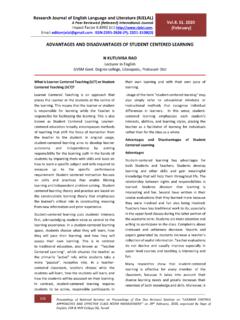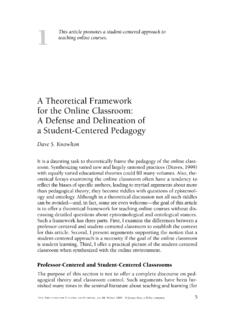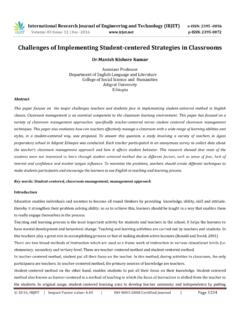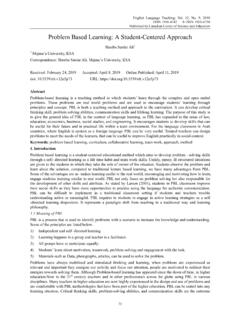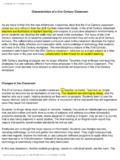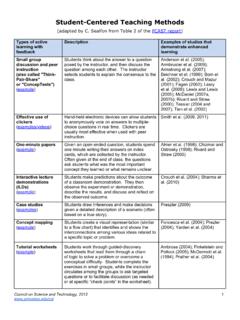Transcription of Evidence for Student-Centered Learning
1 Evidence for Student-Centered Learningby Krista KaputJanuary 2018 About Education Evolving. We are a Minnesota-based, nonprofit, nonpartisan organization focused on improving American public education. We work to advance Student-Centered Learning for all students , by supporting teachers designing and leading schools, and by advocating for policy that is open to innovation. Read more at for Student-Centered Learning | 3 ContentsPart 1: Introduction and Context 5 Part 2: Education Evolving s Seven Principles of Student-Centered Learning 7 Part 3: Evolution of Student-Centered Learning : A Historical Perspective 9 Part 4: Research on Student-Centered Learning as a Whole 11 Part 5: Research Supporting Each Principle of Student-Centered Learning 13 Principle #1.
2 Positive Relationships 13 Principle #2: Whole Child Needs 14 Principle #3: Positive Identity 15 Principle #4: Student Ownership and Agency 16 Principle #5: Real-World Relevant 17 Principle #6: Competency Progression 18 Principle #7.
3 Anytime, Anywhere Learning 19 Conclusion 21 Endnotes 224 | for Student-Centered Learning | 5 Part 1 Introduction and ContextOn April 30, 1983, President Ronald Reagan addressed the nation and declared, Our education system, once the finest in the world, is in a sorry state of disrepair. 1 His assertion was a response to the findings of the 1983 A Nation at Risk report, which was released by the President s National Commission on Excellence in Education. The report highlighted startling statistics about the high illiteracy rates amongst American youth, as well as the steady decline of standardized test scores in reading, science, and Since the release of A Nation at Risk, the narrative that the nation s E-12 public education system is broken and must be fixed has been prominent in reform efforts from President Bush s No Child Left Behind, which scaled high stakes, standardized test-based school accountability.
4 To President Obama s Race to the Top Grant, which provided monetary incentives for states to adopt the Common Core Standards and promote school choice. While these education reform efforts have had a profound impact on E-12 public education, the academic outcomes of the nation s public school students have continued to be In fact, after almost 35 years of major education reform efforts and billions of taxpayer dollars spent, the nation s public schools are still not preparing most students for college and career4 or to be competitive in the global Many employers feel that today s college graduates are not well prepared to achieve the Learning outcomes that they view as In particular, the business community has indicated that college graduates do not possess sufficient skills in mathematics, reading, and in soft skills like work ethic, accountability.
5 And continued failure of the nation s E-12 public education system to successfully educate all students and prepare them for college and career raises the question: Why? Why, after all the time and resources that have been put into fixing our nation s public schools, have education reform efforts failed to create an equitable system that is academically rigorous, relevant, and engaging for all students ? The answer is simple. The design and intention of our country s public education system was never to educate nor meet the needs of all students .
6 Rather, its purpose was to prepare students , in mass, to work in an industrialized and standardized economy. The design of our current public education system was highly influenced by Frederick Taylor s concept of scientific management, which is centered around improving economic efficiency by putting the system first and ignoring the individual. Specifically, scientific management created a centralized, hierarchical structure where management sets rules and procedures for workers to follow, which made their jobs simplified, standardized, and their productivity John Franklin Bobbit, one of the biggest proponents for applying Taylor s scientific management to public education, argued that schools should be like businesses and focus on eliminating waste, efficiency.
7 And maximizing student Bobbit also agreed with Taylor s assertion that efficient outcomes depended on centralized authority and detailed, top-down instruction for all tasks that students performed, and the content that teachers By 1920, most American public schools were designed around the tenets of Taylor s scientific management, treating each student as an average student and aiming to provide each one with the same standardized education, regardless of their background, abilities, or interests. 11 6 | tenets of Taylor s scientific management were not only central to the original design of our current public education system, but they have also persisted and been perfected over time by education reformers like David Snedden,12 Ellwood Cubberley,13 and Edward In fact, in 1993, Doctor Kenneth Gray wrote, it may be inevitable that America will lose the race for international its people are infected with a disease called Taylorism.
8 15 Therefore, education reform efforts have failed to fix the American E-12 public education system because the system is not broken. It is doing exactly what it was designed to do educate the masses in a standardized fashion that completely disregards who students are as individuals or, as American journalist Mencken wrote in 1924, The aim of public education is not to spread enlightenment at all; it is simply to reduce as many individuals as possible to the same level, to breed and train a standardized citizenry, to put down dissent and originality.
9 16 The design and intention of our country s public education system was never to educate nor meet the needs of ALL students . Rather, its purpose was to prepare students , in mass, to work in an industrialized, standardized economy. Evidence for Student-Centered Learning | 7 Just as our economy and industries have changed, so too must our system of public education. Education Evolving asserts that if we truly want to reform or fix our nation s public education system so all students can be successful and have their unique needs met, then we must change the design of the system.
10 Instead of maintaining the current, adult- centered , hierarchical structure where students are the receivers of a predetermined set of knowledge, we argue it s time to redesign the model and system of schooling with students at the center. It s time to design a system that takes into account students interests, Learning styles, cultural identities, life experiences, and personal challenges. It s time to design a system that not only sets all students up for success but that is also equitable and meets their unique needs.










